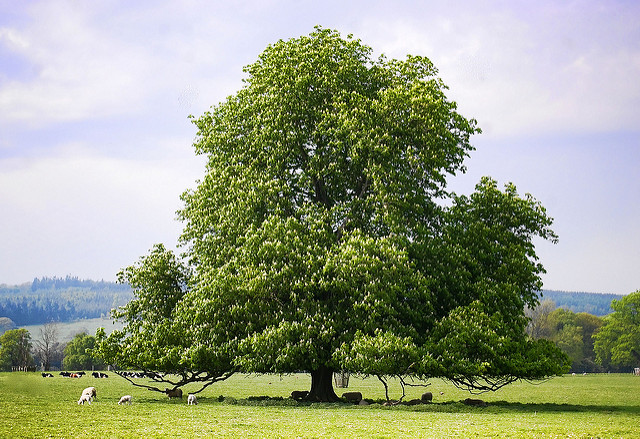"Under a spreading chestnut tree, the village smithee stands."
Most every kid in my time heard or read that opening line in Longfellow's poem The Village Blacksmith. We probably didn't really care about it then, and to be brutally honest, it doesn't do a lot for me now. But there it is, in my head. Kind of like Joyce Kilmer's "I think that I have never seen, anything as pretty as a tree" poem we also had to learn, probably in the same class. Poor Joyce, so deprived of real beauty. What about the bulky lines of a 1963 Dodge 880? Or that perky calendar girl hanging on the south wall of the North Henderson Community Center? Now that is real beauty. To be further brutally honest, if you lined up 5 of the most live trees in front of me I doubt if I could name them. The one exception is the live oak that is all over down here in Florida. That and the palm. But in Northlandia, they all pretty much look alike to me except the weeping willow. Poor education, not paying attention, or just don't care, it is a flaw in my character. Trees are important after all. Something about them making the air I breathe. I'm not sure. Another character flaw.
What I am aware of is that there was a Dutch Elm disease that pretty much wiped out all the elm trees in the early 60's North America. 90% of the elms in Europe and North America vanished.
Also pretty much wiped out is the chestnut that used to be all over the country this is a chestnut tree photographed in 1916.
This is a chestnut tree in Scotland.
There are still horse chestnuts around, mostly out east, but the American Chestnut is gone. They will grow in a bush-like configuration and then will die. The fungus that kills them is in the ground and outside a small area in Michigan and Oregon, they are pretty much gone. The disease was discovered in 1904 and from that time till the mid-50's there were about 5 billion chestnut trees that died.
So we have never had roasted our chestnuts on an open fire, but according to those who have, elsewhere in the world, say they are quite tasty. Other types of chestnuts are imported such as the Japanese which seems to be OK at this point. There is also a Chestnut Foundation that is trying to breed a disease-resistant American chestnut but success is slow, as you can imagine.
I'm not totally naive. I know things change and species ebb while others grow. Some die out completely and new genus spring forth. It is nature. As strong as we think nature is it is also quite fragile and unforgiving. We all live in a time where a fringe world lives that is just starting and a fringe where things die out.
This is an old postcard of Chambers Street where I lived for over 20 years. Our house was just this side of the blue house on the far right. The street was lined with these elms trees as were many other streets and boulevards across the country. They are all gone now.
Dr. Dan Kolbow, my pledge son and roomie my last year at college retired in January and moved to a coastal town not too far from Portland, Oregon from Kansas City. The area that favors the American Chestnut, because of its Mediterranean-like climate, is about an hour away from where he lives. He has promised me he will visit Sherwood and try to find the forest where these guys are. Maybe even get me a leaf.
There is no particular end-game to this post. This wasn't a problem brought on by mankind or its inevitable progress. It's not global warming or industrialization. It was just a bug and a fungus. Maybe its just a simple but profound recognition that all things born in nature thrive and eventually die. Civilizations, eras, nature in all its magnificence, the wealthy and the poor. And even me.



Comments
Post a Comment